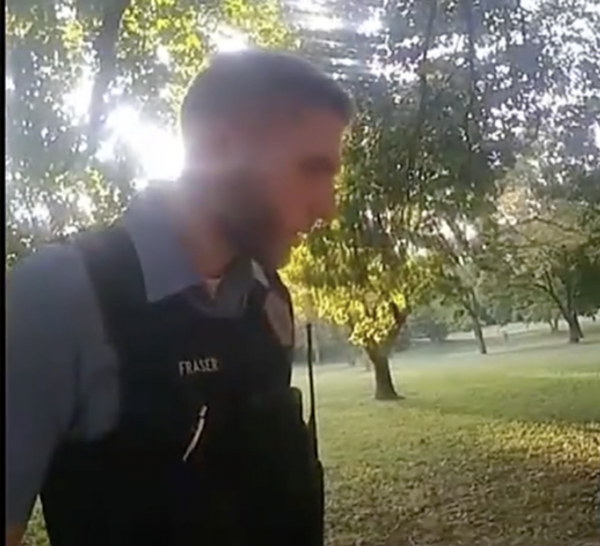
A migrant mother walks in front of a wall outside the Moria refugee camp in Lesbos, Greece, on Aug. 11, a month before the devastating September fire.
LESBOS, Greece—On Sept. 9, Europe’s largest refugee camp, Moria, on the Greek island of Lesbos burned to the ground, leaving nearly 13,000 people frightened and homeless. But to call Moria a refugee camp is an insult to most well-run refugee camps around the world that do not burn down with such predictable regularity. That this incinerated ghetto was a cornerstone of EU migration policy should prompt an urgent and expansive rethink of how to humanely manage a phenomenon that will continue to grow as new conflicts rage and economies collapse.
Before its destruction, Moria had become the kind of hellhole that someone would want to claim asylum from, rather than a place to dump asylum seekers. A crumbling hilltop military base surrounded by olive groves was in 2015 given an Orwellian rebranding by the EU as a so-called hotspot that would act as a giant filter where hundreds of thousands of migrants arriving by boat would be screened, fingerprinted, and relocated around the bloc. A year later, the EU signed a Faustian pact with Turkey to prevent these sea crossings and agree to take back the rejects. Both these approaches had systemic deficiencies.
Though it became effectively suspended for a period during the time of peak refugee flows, the EU’s Dublin Regulations ensure that the first EU country of entry is generally responsible for the asylum seeker’s registration. It is an unjust arrangement that puts huge responsibility on the weaker shoulders of Europe’s Mediterranean states, while wealthier northern nations avoid responsibility for processing arrivals but are given the power to ping-pong people back to where the people first registered. This can result in the resentful frontline country deliberately maintaining a dysfunctional asylum system in the hope that migrants won’t come, or that the rest of Europe will not send anyone back.
For many years, Europe did not return migrants to Greece exactly due to the deplorable conditions for asylum seekers. Keeping Moria as a slum was just another flawed attempt at deterrence. The European Commission on Wednesday announced that the Dublin system would be replaced, with details on its asylum reform package to be announced next week. Seasoned migration experts are not optimistic, having seen a string of other dysfunctional policies over the years.
Afghan women collect their belongings from the Moria camp to bring to the new Kara Tepe facility on Sept. 14.
The so-called temporary emergency relocation scheme of 2015 was an attempt to take 160,000 refugees from the beleaguered frontline states of Greece and Italy and share them between member states. It was slow to start, managed to relocate less than a quarter of its target. It was also bitterly contested by hard-line governments in countries like Hungary and Poland who didn’t want to take any.
It was based on an irrational calculation: It applied only to nationalities with a 75 percent average recognition rate of international protection across the whole of the EU. This created the absurd situation whereby at one Syrian and Iraqi refugees were eligible for the scheme, but also people from countries like Costa Rica and the Bahamas—one or two of whom may have once been granted protection in Europe and thus scored a 100 percent recognition rate. Meanwhile, hundreds of thousands of Afghan refugees were never eligible for the scheme because some member states have classified the country as safe.
As legions of refugees continued to trudge through the Balkans into Europe throughout 2016, Brussels struck a bargain with Turkey. Offering 6 billion euros and promises of visa-free travel to the EU for Turkish citizens, Ankara would apprehend more migrant boats in the Aegean Sea, improve facilities for mainly Syrian refugees in Turkey, and agree to take back rejected asylum seekers from the island hotspots.
Four years later, the flow has slowed down but not stopped, the crucial deportation element of the deal was frozen by legal challenges and Ankara’s frequent refusals to readmit people, and President Recep Tayyip Erdogan has become an increasingly dubious partner. Relations with the EU soured so much that in March this year he ordered thousands of migrants to be bussed to the Greek land border, which resulted in days of mayhem and the deadly shooting of a young Syrian refugee. It’s a tried and tested formula. Libya’s Muammar al-Qaddafi used to regularly shake down Europe for billions by threatening to send migrants across the sea.
The main road of Moria camp on Sept. 10.
The Greek government has so far arrested six Afghans whom they accuse of setting the fires that razed Moria to the ground. Before the fire, Moria was home to nearly 13,000 in a facility barely designed for 3,000. As informal shanty towns sprouted up around it, the inmates became increasingly desperate and irate over the seemingly endless delays to their asylum procedures and the conditions in which they were forced to dwell while a carousel of Western humanitarian workers and journalists trooped in and out by day before returning to their comfortable hotels by night. Last week’s arson was a reprehensible act, and it is a mercy that nobody was killed, but forcing people in legal limbo to live in squalor tends to have adverse outcomes.
Beyond the spectacle of refugees, people tend to forget that Lesbos is a place where people live. While the United Kingdom goes apoplectic over a modest increase in refugee boat arrivals from France, the people of Lesbos continue to accept hundreds of thousands of those displaced by distant conflicts with remarkably good grace considering the precipitous decline in tourism that their migrant penal colony status has caused.
Most of the islanders descend from Greek refugees forced over the Aegean Sea by boat from Turkey in 1922 when both sides expelled their minorities. The few far-right vigilantes, including members of the fascist Golden Dawn party, that have lately attacked refugees, NGO workers, and journalists are not representative of the island, but locals do continue to resist any attempt to construct further migrant facilities, fearing they will be permanent. On this point, they are united with the refugees who fear the same.
As Moria lay smoldering, urgent meetings were held in municipal buildings over what to do with the refugees, what to do with the locals blocking nearby roads in protest and what will happen to the jobs of those who worked at Moria. Outside, I met an engineer from Lesbos working at the camp, who described the years of driving over the hills through dusty tracks to avoid sporadic outbreaks of violence by refugees and roadblocks erected by enraged local villagers. He sees them as prisoners of the same situation.
“People live next to Moria, they have children and old people and they are scared at night. But nobody ever writes about them. And Europe gives us money to build a prison here for the refugees but doesn’t solve their wars.”
In March, residents of Lesbos revolted against police officers drafted in to protect new camp sites, beating them up and forcing them to flee back to the mainland. In the last few days, ferries have been arriving from Athens full of riot police platoons equipped with water cannons, suggesting that Moria 2.0 will be implemented at the behest of Brussels even if Athens has to go to war with its own Aegean islanders.
A refugee woman cries during a protest in the main street connecting Moria to Mytilene, Lesbos, on Sept. 12, reacting to plans to move refugees to a new camp.
When I flew into in Lesbos last week, I saw a line of fidgety refugee children queuing outside the airport, part of the 400-strong contingent of unaccompanied minors that the European Commission hurriedly agreed to evacuate to the Greek mainland. Since March, a scheme run by the International Organization for Migration has relocated 750 unaccompanied and vulnerable children, including their families, to Europe. Germany has accepted more than two-thirds of them, while only five other EU states have taken in a handful.
While it’s obviously a good thing, airlifting the only type of refugee European governments can sell to disgruntled electorates back home is a cynical approach to the problem in lieu of a comprehensive strategy the EU has had years to devise. It does not solve the issues faced by thousands of children accompanied by their families, much less fathers and adult sons travelling on their own, who are often the sole breadwinner for a family.
The day after the fire, I met Abdul Azim, a 26-year-old father and member of the persecuted Hazara community from the Afghan province of Ghazni, pacing around in the blistering heat. After almost a year, he had just managed to upgrade his tent in Moria to a container a few days before the fire broke out. He grabbed his wife, baby, and asylum documents and ran toward the sea to escape the flames. Most refugees currently on Lesbos are Afghans. Twenty years after the U.S. invasion to remove the Taliban, the militant group is now conducting peace talks with U.S. officials and could be on the verge of regaining political power—a development that would continue to poison the atmosphere and cause people like Abdul to flee.
“People ask me, ‘Why do you come here?’ The Taliban demanded half of my salary upon pain of death and my daughter won’t be allowed to go to school,” he explains.
Despite arriving in 2019, he received a date for his family’s asylum interview for 2021, and now fears that the fire will delay the process further.
Abdul has had ample time to observe the political dynamics that govern his life and sums it up succinctly:
“Europe gave Turkey money to keep us over there, now they give money to Greece to keep us here.”
Migrant children protest in the main street connecting Moria camp to Mytilene against plans to move to a new camp on Sept. 12.
The EU approach of exploiting frontier countries’ geography by using them as barrier to the wealthier north goes alongside a number of violent measures, including sending migrants adrift at sea and shooting at them in forests at night. These gross human rights abuses have been met with promises by the highest levels of EU leadership to establish a “monitoring mechanism,” but as I wrote in in November 2019, these mechanisms do not exist.
During her State of the Union Address on Wednesday, European Commission President Ursula von der Leyen stressed that Europe would take a “human and humane” approach to migration and that “saving lives at sea is not optional.” As long as the EU provides training, equipment, and funding for Libyan militias to apprehend refugees fleeing to Europe and return them to face torture, rape, and bombings in an active war zone, it is difficult to take migration proposals seriously.
In early 2016, an EU official told the Wall Street Journal that “Greece wouldn’t be the worst place to have a humanitarian crisis for a few months,” and in many ways it was an honest reflection of the prevailing attitude in Brussels. Not much has changed. Though Moria has been destroyed, the European Commission is already financing the construction of new facilities on the Greek islands while at the same time insisting on EU-wide relocation again. The latter is an even harder sell in a continent where nativist politicians are on the march, so the fate of refugees is likely to be extended captivity while Brussels hurries to bribe more authoritarian countries to act as migrant warehouses. The beefing up of the Frontex border agency heralds the advancement of a deportation machine with questionable approach to transparency and human rights.
Structures show signs of the fire at the Moria camp on Sept. 10, the day after the fire.
Given that most of the world’s refugees flee to neighboring states, it would make far more sense to spend the same money on meaningful global resettlement plans from countries that host vast numbers of displaced like Pakistan, Lebanon, and Uganda and stop using them as human warehouses. After all, there is a reason people don’t stay in those countries. During the height of the refugee crisis in 2015, not all Syrians had raced to Europe straight from their bombed-out homes; many attempted to repair their lives in overcrowded neighboring states like Lebanon or Turkey. However, faced with barriers to their employment and education for their children, and vanishing legal means to escape, they voted with their feet and headed for Europe through the back door.
And for the fortunate ones who can return home safely, the EU must expand education and work visas so they can benefit from experiences in wealthier countries to assist when they return home. Not doing so simply pushes migration facilitation into the hands of transnational criminal networks who then line the pockets of corrupt border cops in transit countries already hollowed out by corruption.
Cherry-picking a few children who must take a deadly boat crossing to get to Europe in the first place is no solution. Denying basic dignity to the tiny percentage of those who make it to European shores doesn’t stop the movement; it just prolongs their suffering. Bribing dictators to lock up migrants will backfire and detaining migrants en masse during a pandemic has grave public health implications.
Of the 9,000 asylum seekers from Moria who have moved into a nearby tented camp built on a former military firing range, 213 have now tested positive for COVID-19. Reports of poor sanitary conditions and overcrowding are already emerging from this new facility, which is perched perilously close to the sea and ringed with barbed wire. Lesbos is just one island. If this manufactured drama is allowed to play out throughout the winter months across Europe, the consequences will be deadly.













